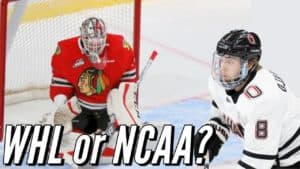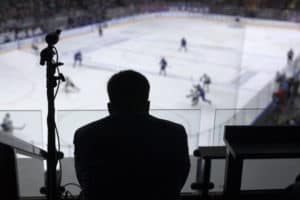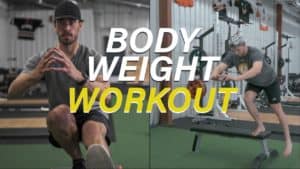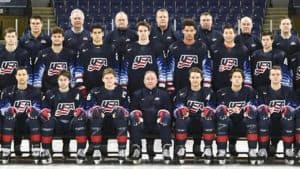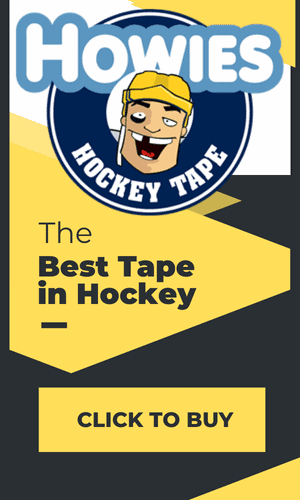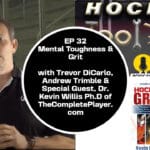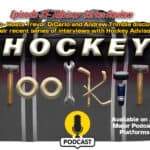5 Myths of Off Ice Training
By Andrew Trimble- GM New England Wolves EHL & Owner- www.scoringconcepts.com
We are currently right in the thick of season. Players and parents are planning for winter tournaments, holiday showcases, and great 2nd halves to their season. Many players are also coping with the cancellation of their season, or have stopped somewhere in the middle of their year to go into quarantine or remote school.
With this article I’ll debunk some of the common myths I’ve seen and experienced with Off Ice Training. I hope it comes at a time when players need it, and can apply it to keep engaged in the game if they are not having a complete or full hockey season. I hope it informs you and gives you that little extra level of motivation.
MYTH #1- The Cabbage Patch Kid
In the winter of 1995 I had to get a backyard rink kit. I saved up my money for months from working in the Pro Shop at the Ocean Ice Palace in Brick, NJ, and purchased a kit via mail-in order form off the back of one of my favorite hockey magazines. The kit arrived in October and I was setting my rink up by November. It was going to be MY WINTER… the winter where I got up at 5am everyday in Manasquan, New Jersey (a coastal town in Monmouth county about 50 miles south of New York City), practiced on my backyard rink and transformed into Scott Niedermayer.
Sadly, the temperatures on the Jersey Shore in the winter of ‘95 weren’t ideal for freezing ice. I got a couple days of skating in, and several “crack of dawn” skill sessions in before school, but not the 3 months of uninterrupted development I was hoping for.
We’ve all seen an ad in the Hockey News or USA Hockey Magazine about THE PRODUCT. The one “Must Have” tool that will transform your athlete into Connor McDavid. Synthetic Ice, Rebounders, Treadmills, Skate Weights, Weighted sticks, Bungee cords, Stickhandlers… they all have a share of a piece of the pie that will make your player into the NEXT ONE. I am not disparaging these products. They all can be great tools to help your athlete refine a skill, enhance his game, and improve his or her performance.
Studies have shown The Youth Sports Industry in the US is a 9billion dollar industry that employs over 250,000 people (Sports Coaching in the US – Industry Data, Trends, Stats | IBISWorld). The hockey world and sports industry at large will always find new products and tools to help our kids improve. That’s a guarantee.
“Wally’s Coliseum.” Most acknowledge that he acquired his skill and instinct of the game by playing on his backyard rink.
Soon after, his dad, Walter Gretzky, decided to make a backyard skating rink for him in order to have fun and practice his skating techniques. Wayne soon developed and mastered his unique skating stride.
During those early years, Gretzky developed his passion for playing hockey and for skating outdoors. (Wayne Gretzky (mybackyardicerink.com))
The only way a kid is going to practice is if it’s total fun for him… and it was for me.- Wayne Gretzky
Looking back on my childhood now, the one product that did help me improve the most and develop my hockey skill was finding a love for the game. Countless hours were spent with my friends playing roller hockey at the Presbyterian Church parking lot in Manasquan. When we would hit a car or get yelled at by either the Janitor or the Pastor we’d move the game across the street to the United Methodist Church. We did this for years. We accidentally broke some bones and a few windows in the process.
Eventually the town recreation department gathered up the funds and my friends and I helped to turn an old tennis court down on first avenue (a block from the beach) into the first “Roller Hockey Rink” in Manasquan. 3-4 years later when I was playing hockey in college, they raised enough money in the town to turn the basketball court at the Little League field into an unbelievable roller/street hockey rink with boards, benches, nets and much more. It’s still there today, and it’s awesome.
None of this was created by one thing. It was kids who loved to play, and who needed a home to do so. Out of that group of 6 or 7 friends (which didn’t even have a High School team to play on till the school created one in their Junior year of High School), 4 went on to play some level of College Hockey.
Although they certainly help, no one drill or one tool will transform your athlete. Your kid has to want it. They have to self-discover and go to great lengths to improve themselves. They have to carve out the time, turn off the devices and pick up their stick. They’ll need to work and overcome obstacles and barriers. They’ll need to LOVE TO PLAY.
MYTH #2- Sportscenter
In 2009, the Nielsen Co. reported that children’s television viewing had reached an eight-year high. Children ages 2 to 5 watched TV for more than 32 hours a week. Kids ages 6 to 8 spent 28 hours per week in front of the tube, most likely because they were in school, explains Nielsen. The Kaiser Family Foundation also conducted research on the media habits of children ages 8 to 18. Kaiser found that on average, this age group spends 4½ hours each day watching TV in various forms, including on their mobile phones and the Internet.
More than 70 percent of children ages 8 to 18 have TVs in their bedrooms, according to the University of Michigan Health System. More than 35 percent have cable or satellite-TV access. Criticism of the effects of TV on children is documented. But with your guidance, TV can also be a positive influence in your child’s life.
What Is the Family Impact on Early Childhood Development? (hellomotherhood.com)
It has never been easier to watch Full NHL games and your favorite NHL players. With Youtube, the NHL network, regional Sports Cable networks, Social Media and the internet… This current generation of kids can see players the best players from all over the world everyday. But do our kids actually watch hockey?
In the summer of 1978, the Rasmussens… – began to seek out support from cable operators and potential investors for the sports channel which they had come to name the Entertainment and Sports Programming Network (ESP).[2] They began to pitch their idea on June 26 of that year, inviting twelve representatives from local cable operators – only five of whom had accepted the offer. The representatives that were present were skeptical of the concept and stated that it would be impractical and too costly to take a risk on something that would seemingly falter.[2] Despite the setback, the team held a press conference to help spread the word…on August 16, 1978, both father and son agreed that the channel would show all types of sports 24 hours a day, have a half-hour sports show every night, hire sportscasters and buy a fleet of trucks to travel across the nation covering various sporting events. History of ESPN – Wikipedia
With the advent of shortened programming, shortened attention spans, and more tools to distract kids, many youth hockey players do not watch Full Hockey Games anymore. They watch 10-15 second clips (or Highlights) of the action. Whereas this isn’t necessarily bad, it is certainly different than a generation or two ago, and it only gives a brief snapshot of the game. It makes the game more an individual sequence, rather than the 5 v 5 Full Ice game that hockey is.
For example look at the numbers for Hockey Night in Canada. An institution for more than 50 years, Hockey Night in Canada (for several reasons) has seen a steady decline in viewership. What once was shared as a family on Saturday nights in the great white north has become in many cases an afterthought.
“Eastern games on Saturday nights on the CBC and the Rogers networks had an average audience of 1.696 million, down 6 percent from the same period a year ago when the games were only on the CBC and drew an average audience of 1.803 million.” – David Shoalts. Globe and Mail. Published: Jan. 30, 2015.
“Things are worse for the Western games, as the average audience from December through January was 765,000, a 19-per-cent decline from the previous year.” – David Shoalts. The Swift Decline of Hockey Night in Canada (thehockeywriters.com)
In this time of remote learning, at home instruction, quarantines and isolation, let’s take time to reevaluate what we are watching and how we are watching it. Sitting down and watching FULL games with your kids and family will make a huge difference in how your player views hockey. They’ll see full sequences of action, how plays develop and how teams defend. They’ll understand what players play in what roles and how a game and momentum can move within a contest. They’ll see penalties. They’ll see Power Plays for the full duration (including the breakout). Watching full contests is a game changer.
In Search of Greatness, from director Gabe Polsky, presents the theory that greatness in sports comes not from repetition like we see in structured practices but through artistry and passion. Gretzky is held up as an example and, in an interview, agrees with the premise. He loved the game so much that he continued to work at it … There’s a famous story about Gretzky sitting in front of the TV, tracing the path of the puck and absorbing on some subconscious level how the game of hockey flows. Wayne Gretzky is the GOAT athlete in the history of team sports (usatoday.com)
Remember… players can learn just as much on a play that didn’t go into the back of the net, as they can from a play that did.
MYTH #3- White Goodman and Globo Gym
In thirty days I’ll be bulldozing that shit-heap you call a gym into permanent nothingness. And I can only hope that you, and the mongrel race that comprise your membership, are inside it when I do. White Goodman- Dodgeball- 2004
Olympic Skier Bode Miller is world renown for his unique skiing style and technique. Additionally, growing up in rural New Hampshire, his training regime became stuff of legend. Utilizing at home sometimes homemade devices, or experimental techniques such as restrictive blood flow or Kaatsu, Miller championed new and creative ways to train for sport at the highest level.
Yet, a primary focus for Miller’s training can’t be bought, used or built in any gym. Its built in the kitchen.
“I think eating is critical, super super important,” he says. “The problem is people want to eat healthy but they also want something that they like or that tastes good. I don’t eat cake or masses of candy, but at the same time I don’t restrict myself from eating a hamburger if that’s what I feel like.” His focus is more on ingredients. “A part of it is being cognizant of the chemicals. If it’s natural food, I don’t think a burger is necessarily bad. Highly processed chemical-infused food is the problem, you have to limit the quantity and frequency that you take it in.” How Olympic Gold Medalist Bode Miller Stays Fit (With 4 Kids) | GQ
Far too often young athletes will focus on getting on the fashionable new training routine, or attending the new million dollar Training facility. Young athletes and parents will spend thousands of dollars on equipment and personal trainers to condition and develop their players bodies for the sport of hockey, yet they will completely overlook the critical component of nutrition to fuel their young athletes bodies.
A well-balanced diet is essential for growing athletes to maintain proper growth and optimize performance in athletic endeavours. An ideal diet comprises 45% to 65% carbohydrates, 10% to 30% protein and 25% to 35% fat. Fluids are very important for maintaining hydration and should be consumed before, during and after athletic events to prevent dehydration. Timing of food consumption is important to optimize performance. Meals should be eaten a minimum of 3 h before exercise and snacks should be eaten 1 h to 2 h before activity. Recovery foods should be consumed within 30 min of exercise and again within 1 h to 2 h of activity to allow muscles to rebuild and ensure proper recovery. Sport nutrition for young athletes (nih.gov)
As Miller attested to, ingredients are important. Fast food can provide fats, protein and carbohydrates, but the methods they use to store, transport and cook those foods can wipe out any nutrition provided in those meals.
I know it’s hard for parents sometimes to get their kids to eat healthy, but healthy eating is critical to Off Ice Training. The gains made at the gym will be destroyed by any workout at even the worlds best gym or by the world’s best trainers when coupled with a poor diet. Hydrate with water. Have color on your plate. Avoid fast and processed food. Use natural ingredients, and limit sugar. When athletes do this in combination with workouts, they will see tremendous gains quickly… whether they are at the gym at home, in the driveway or at Globo Gym!
MYTH #4- Youtube Rots Your Brain
I know I criticized the consumption of youtube, highlights and social media on Myth #2, so I may come off as a hypocrite in Myth #4 but hear me out.
Highlight watching on youtube definitely does not give young players the full story, the full picture of a game, goal or player. When utilized in different ways, however, youtube can be a tremendous tool for teaching the game. Here are 10 ways or content creators on Youtube can improve your players game off the ice:
- Rebroadcasts of analysts segments from NHL Network- 5min clips from Scott Stevens, Kevin Weekes or others that provide insight and clips into the game
- Shooting Tutorials from Coaches and Players
- “How to Hockey” – Tips on defense, shooting, puck skills and much more that appeal to kids and provide insight on skill acquisition
- Hockey Insights from Coach Eaves- PBS Wisconsin has put out a number of great videos from U of Wisconsin Coaches on Forechecking, Power Play and much more
- Championship Productions- formerly a VHS or DVD company that specialized in coaching tutorials, now Championship Productions is online and can provide drills, interviews, tips and much more
- Skating Tutorials from Power Skating Coaches
- “Evolution Hockey”- This youtube creator has some great clips on Winger Breakouts, Redirects, Quick Releases and much more. They use NHL clips to demonstrate the concept which kids love.
- Alex Antropov has 2.26k subscribers. He’s a Russian skills coach that teaches kids of all ages. Great, fun videos for kids that can show them a new drill or skill that they can they bring to their practices or skill time
- The Hockey Think Tank- also a great podcast for kids and coaches. Topher Scott voice overs clips of a variety of NHL players and much more. He provides great detail and insight.
- Historical Players- We couldn’t do this in the 80s! Players now can see highlights of Bobby Orr, Bobby Hull, Mario Lemieux, Wayne Gretzky, Eric Lindros, Martin Brodeur and much more, at just a click of the fingertip.
Youtube and social media can be great for your kid in combination with watching full games. Think of a skill that you want to improve upon and type it into the search box. Hundreds of clips are available to our athletes that a generation ago they’d have to hire a specialist to teach them.
MYTH #5- No Days Off
We’ve all heard parents or coaches boast about their “Training Model” for their players. Parents drive kids from state to state for multiple games each weekend, school, then multiple practices, skills, workouts each week. Repeat- Repeat- Repeat.
Research has shown that our heavily scheduled lives have contributed to a significant decrease in the amount of free time kids have, so their independent play skills may not be ready for the moment we are facing.
That’s OK. With a few tools, experts say, we can teach our kids how to play more independently, which will reward them with lifelong benefits. “Independent play encourages time management, executive function and organizational skills, and emotional and physical awareness and regulation,” said Dana Rosenbloom, a parent and child educator in Manhattan. “All skills that help us be successful individuals as adults. https://www.nytimes.com/2020/04/03/parenting/kids-independent-play-coronavirus-quarantine.html
Kids love hockey, and kids want to play. I get it. We all remember the days on the street hockey rink or on the pond where we showed up first thing in the morning, and did not stop playing the game until our mom called us in for dinner. Hockey is the greatest game on earth. It has speed, grace, skill, competitiveness, grit, toughness…
Yet, studies by USA Hockey and other governing bodies of sport have shown the usefulness of multiple sports and participation in a wide variety of activities. They include:
1. Fewer overuse injuries. Growing bodies can become overstressed by repetition and that stress can lead to injuries. A lack of rest and recovery time in year-round sports exacerbates the problem. There are plenty of examples of serious, grown-up sports injuries happening to kids at younger and younger ages, from Tommy John surgery for 12-year-olds to high school girls with multiple ACL injuries before they graduate. Studies show that playing multiple sports leads to better muscle, motor and skill development. It promotes general athleticism, balance, speed and agility.
2. Less opportunity for emotional burn-out. Kids who spend so much time focusing on one sport — and whose families are similarly solely focused — risk tiring of the sport all together. Specializing raises expectations, the costs for parents for travel and club teams and the pressure on young athletes. Having a variety of experiences keeps things interesting, the monotony of a single sport goes away, and so does that pressure.
3. Exposure to different kids. Soccer friends will be different from swimming friends, who will be different from the kids in your Tai-Kwon-Do class. Exposing kids to different sports allows them to share teammate experiences and make memories with a diverse group of peers. It helps them expand their social circle and their opportunities for interaction.
4. Exposure to different roles. Being a bench player on the basketball team is a different experience than being a starting pitcher on the baseball team. It’s an opportunity to broaden their experiences, socially and developmentally. It’s an opportunity to become a better competitor and all-around athlete, the kind that coaches value because they are flexible, multi-dimensional, exposed to many situations and coachable.
5. Not putting all your eggs in one basket. Playing only one sport limits your options. An injury, a bad experience with a coach or a reduced role on a more competitive team can bring an abrupt end to an athletic career. Such a small number of high school athletes move on to play a sport in college; even fewer earn an athletic scholarship. If the goal is to play as long as possible, perhaps it makes the most sense to play as many sports as possible? Just ask Derek Jeter, who played basketball in high school, or Elena Delle Donne, who played volleyball at Delaware before returning to the basketball team on the way to the WNBA, or Robert Griffin III, who played baseball and ran track. 5 reasons you want your kid to be a multi-sport athlete (espn.com)
There will be a time for specialization. All athletes (except if you are Bo Jackson) reach a point where they realize their future and their joy of sport resides in putting their hopes into participation with one sport or activity. Studies have shown that putting off your specialization in sport until after puberty has a far more beneficial outcome than early specialization. So encourage your youth athletes to try new activities and new sports. They may want more hockey, but limiting it early on may make them love it more down the road and look forward to it more in the future. Additionally, you will create a more well rounded human and hockey player.
Andrew Trimble is the General Manager and Co- Owner of the New England Wolves Hockey Club. He is also the Owner of Scoring Concepts LLC, a New Hampshire based hockey training company that offers camps, clinics, private lessons and teams. He has coached at all levels from Learn to Skate to College Hockey. For more info on his teams and programs check out- www.scoringconcepts.com or www.ne-wolveshockey.com

